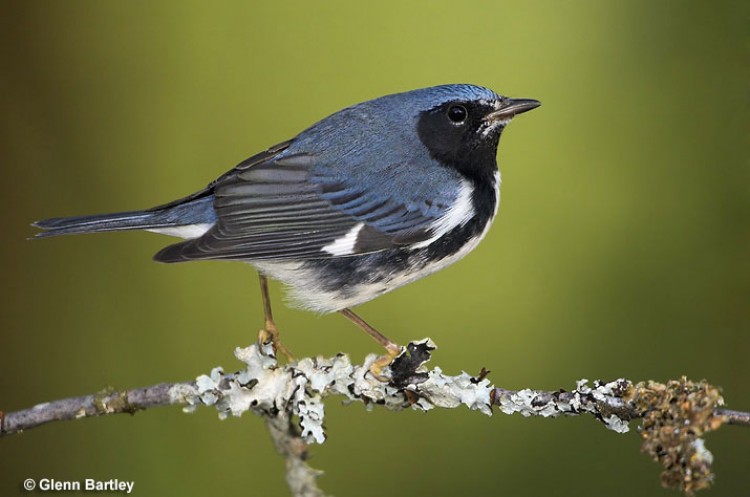The Black-throated Blue Warbler (Setophaga caerulescens) inhabits the deciduous and mixed woodlands of eastern North America. The species got its name from the male’s stunning blue upperparts and black throat.
Females, however, look so much different that at first, they were described as two different species! There is more to discover, so take a closer look.
On this page
Identification
Male
Black-throated Blue Warblers are small but bigger and less slender than most other warbler species. They measure 4.3-5.1 inches long, weigh 0.3-0.4 ounces, and have a wingspan of 7.5-7.9 inches. Both sexes have a thin black bill and white patches on their wings. Their plumage is brighter during the breeding season and duller during fall and winter.
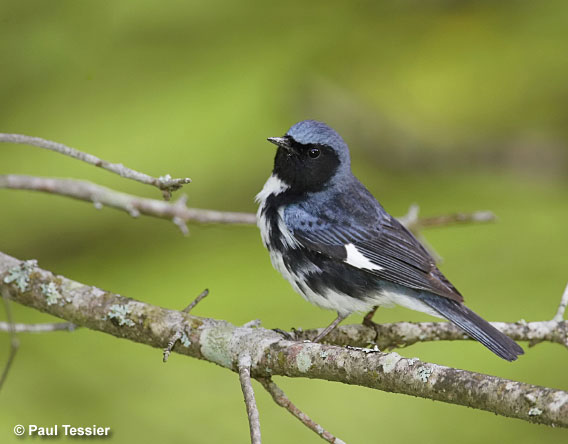
This species is sexually dimorphic. Male Black-throated Blue Warblers have a white underside, black face, throat, and wings, and deep blue head and back. Immature males look similar to adults, but their upperparts are greener.
Female
Female Black-throated Blue Warblers are much plainer and less noticeable. They are dull olive overall with pale buffy or yellowish underparts, buffy eye stripes, and have a white semi-circle under their eyes.
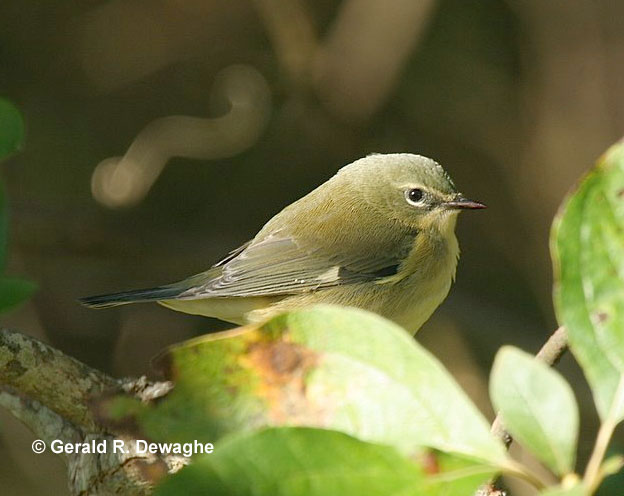
Their wings and tail are slightly darker than the rest of their plumage. Juvenile Black-throated Blue Warblers are even less distinctive than the females! They are brown, have a light eye stripe, and brownish spots on their underside.
Vocalizations
Black-throated Blue Warblers have two main songs, with males predominantly singing. One consists of 3-7 buzzing notes that ascend at the end and the other is composed of 2-5 notes that descend at the end of the song.
The songs can be described as zee-zee-zee-zreeee, zee-zee-zhurr, I am so lazzzy, or please, please, please squeeeze. They call with high-pitched tink and chip calls.
Food
Black-throated Blue Warblers are primarily insectivorous. In the summer, they feed almost exclusively on insects, beetles, butterflies, moths, bugs, caterpillars, crane flies, and spiders. However, in the winter, their diet shifts to include not just insects but also seeds, berries, small fruits, and flower nectar.
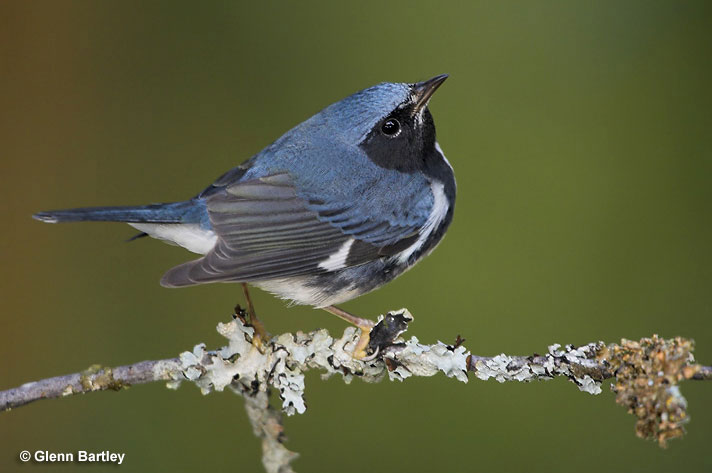
Black-throated Blue Warblers are known for being thorough foragers. They can be found scouring the forest understory, undergrowth shrubs, lower tree levels, and even within the forest canopy.
Most commonly they either glean insects among foliage or hover briefly to snatch their prey from the underside of leaves. However, you may also see them catch insects mid-air or even rob them from spiderwebs. Females usually forage lower than males.
Nesting and Eggs
These charming birds form pairs just a bit after arriving on the breeding grounds. They remain devoted to each other for the duration of the breeding season, with males vigilantly guarding their mates from other males. Although they’re generally monogamous, some males may keep multiple females. About 80% of the pairs remain together from season to season.
Black-throated Blue Warbler’s nests are typically 3-5 feet above the ground, nestled in a branch fork within the dense understory shrubs or saplings of the forest. It is in these well-hidden niches that the females construct their nests. Males assist by gathering the necessary materials.
The cup-shaped nest is composed of bark strips woven together with spiderwebs, plant fibers, and saliva. The interior is lined with softer materials, including pine needles, moss, and hair.
One pair typically produces one to three broods during a single breeding season. The clutches commonly have four eggs, although they may vary in size from 2 to 5 eggs.
Black-throated Blue Warbler’s eggs are small, measuring between 0.6 to 0.8 inches in length and 0.4 to 0.6 inches in width. They have a creamy white base color adorned with reddish-brown and gray blotches, which are especially concentrated towards the larger end.
After the female has laid her eggs, she incubates them for 12-13 days. The young warblers are fed and nurtured by both parents. They spend about 8 to 10 days within the nest, gradually developing the strength required for flight. After fledging, these young birds remain close to the nest for an additional 2 to 3 weeks, during which time they are cared for and protected by their parents.
Current Situation
Black-throated Blue Warblers range throughout eastern North America, the Caribbean, and the Caribbean coast of Central America. During the breeding season and migration, you may meet them in southeastern Canada and the eastern United States. In the winter, however, they fly to the Caribbean or Central America, with some individuals remaining in the southernmost tip of Florida.
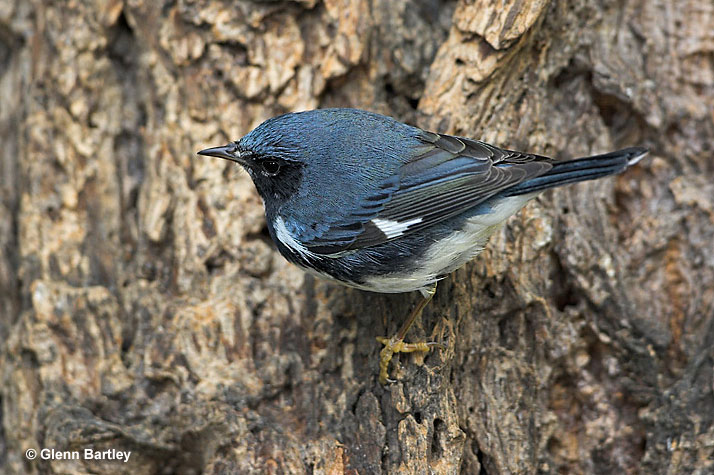
Black-throated Blue Warblers inhabit deciduous or mixed forests, preferably with dense and shrubby understory.
During the breeding season, you may find them in maple, birch, beech, hemlock, spruce, or fir forests, whereas on their wintering grounds, they make dense tropical woods and gardens their home.
Black-throated Blue Warblers are listed as a species of least concern with a stable population. However, we should keep in mind that they are sensitive to forest fragmentation since they prefer to live in large areas of undisturbed forests.
Facts
- As you may have already noticed, the female and male Black-throated Blue Warblers look very different. That is why researchers originally thought that males and females were two different species! The female was called the Pine Swamp Warbler.
- Although their plumage gets a bit duller during the non-breeding season, then this warbler species never actually molts! You can easily identify them year-round.
- Researchers have discovered that northern Black-throated Blue Warblers strongly prefer to mate with individuals who sing local songs whereas individuals from the south don’t have a preference.
- The oldest known Black-throated Blue Warbler lived to be 9 years and 8 months old.
Similar Species
Male Black-throated Blue Warblers have a rather distinct appearance. Females, however, look similar to many other warbler species. We have introduced the three most similar ones down below.
Orange-crowned Warbler
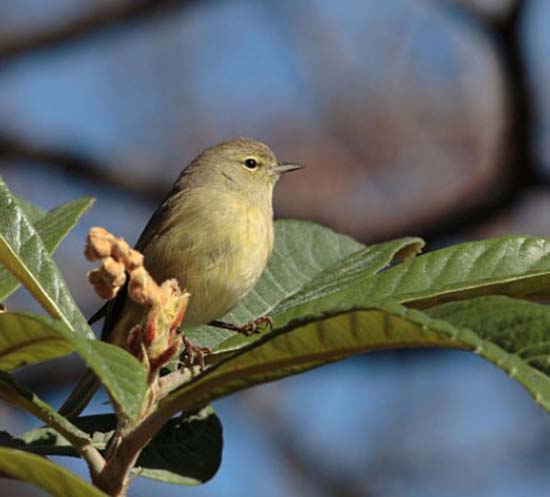
Orange-crowned Warblers range throughout North and Central America. You can find these yellowish-olive birds in thickets and in forests with dense undergrowth.
They’re about the same size as the Black-throated Blue Warblers but are noticeably greener and have a very sharply pointed bill. As the name suggests, they have an orange crown, which our Black-throated Blue Warbler lacks, but in return, the Orange-crowned Warblers lack the small white patch on the wings.
Tennessee Warbler
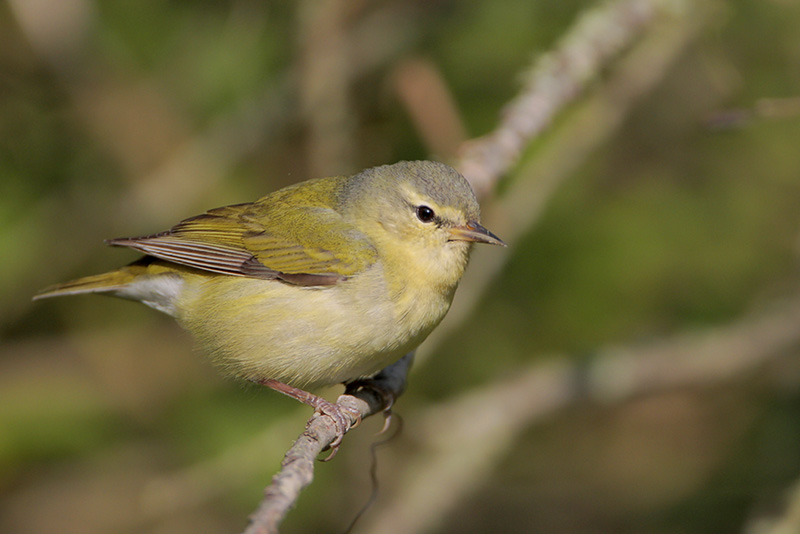
Tennessee Warblers have a very similar range to what the Black-throated Blue Warblers have, but it extends further north and west. They prefer the same type of habitat.
While breeding males and females are easily distinguishable, then non-breeding and immature birds look similar to female Black-throated Blue Warblers. However, they have more yellow in their plumage and lack the white on their wing.
Common Yellowthroat
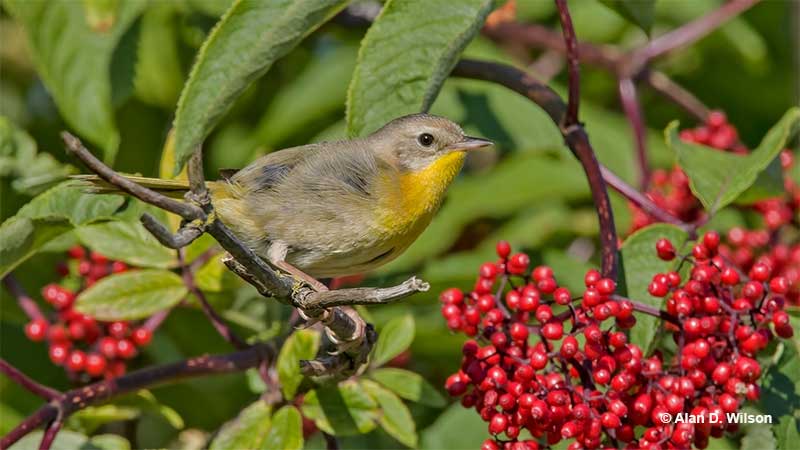
Although Common Yellowthroats and Black-throated Blue Warblers share a love for brushy and concealed habitats, you may find yellowthroats in more open spaces rather than forests.
They range throughout the swamps, marshes, thickets, and brushy areas of North and Central America. Female Common Yellowthroats have uniformly dull light brown upperparts and yellowish throats and undertail coverts.
However, Black-throated Blue Warblers have white undertail coverts and light brownish throats. Common Yellowthroats also lack the white wing patch.
Frequently Asked Questions
Are black-throated blue warblers rare?
Black-throated Blue Warblers are rather widespread and numerous.
What sound does the Black-throated Blue Warbler make?
Black-throated Blue Warblers sing with buzzing whistles that sound like zwee-zwee-zweee or please-please-squeeze.
How big is a Black-throated Blue Warbler?
Black-throated Blue Warblers are about the size of a sparrow. They measure 4.3-5.1 inches long and have a wingspan of 7.5-7.9 inches.

